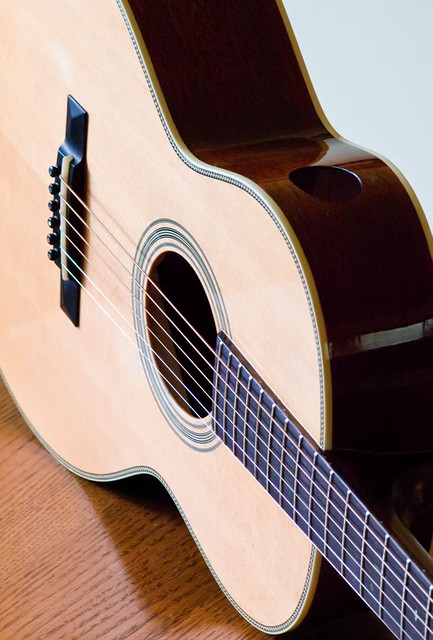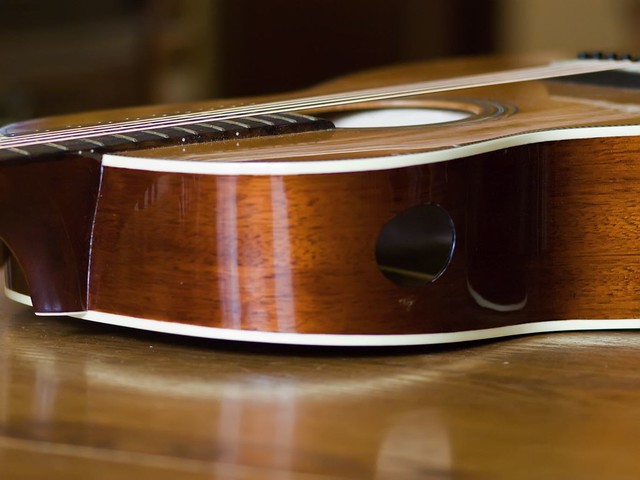
 |
|
#1
|
||||
|
||||
|
Every once in a while I surf the net for guitars I will likely never be able to afford (or at least justify the cost of to my better half). I am currently without a classical guitar and I miss it, so I've been "window shopping". I'm noticing that many of the high-end ($5K and up) classicals these days are being built with an additional sound port in the upper bout, close to the neck?
Just curious if this is really functional and serves a purpose (as I suspect), or is it simply a "new wave" design based on the perception of providing an improvement? This seems relatively new, as 15+ years ago I don't recall ever seeing this. As with everything, I'm sure classical guitar building has evolved, but I'm curious of the purpose of the additional port, and why the steel string builders haven't seemed to adopt it. Any guesses? Thanks, Dale P.S. - In my price range, I'm impressed with Pavan; however, I'm a bit leary of buying one sight-unseen (and unheard). |
|
#2
|
|||
|
|||
|
I think they are meant as a monitor (of sorts). When I was an undergraduate, my professor bought a ported Robert Ruck guitar that sounded and played every bit as good as he paid for it ($5500). The side port allowed me to hear my playing and get a better idea of what the audience would be hearing. Aside from that, the Ruck is a loud guitar, but not much louder than my Peter Barton which is a smaller Hauser/Romanillos body type.
Oh, and the Pavans are indeed pretty nice for the price. IIRC, Pavan has a reasonable return policy if you don't like the guitar. |
|
#3
|
|||
|
|||
|
It is my understanding also that it is for the player. I knew a fellow who cut a side port into an inexpensive student guitar. He claimed he heard the guitar better and that it didn't hurt the original tone of the guitar. I can't confirm that claim as I couldn't do a before and after test.
|
|
#4
|
|||
|
|||
|
Do a search on the forum for the words sound port (or maybe soundport?). You'll find lots of discussion of these in the context of steel string guitars. Some of the higher end steel string guitars are built this way. Some folks add them to existing guitars. Some folks seem to like them a lot, while others either don't like them or don't find value in them.
|
|
#5
|
||||
|
||||
|
Quote:
First of all, side ports are not new, and they began on classical guitars and have migrated to the steel string cousins as well. They are for the player primarily (though there are experimental guitars with no front soundhole, and only side ports). They do improve sound to the player, and they don't affect the sound from the audience perspective other than a minimal amount of increase to any audience members who are sitting closer than 10 feet away. Al Carruth has done pretty extensive testing even building a model called the Corker. Corker - CLiCK I've owned 3 guitars with side ports added after the fact, and in each case it improved the sound from the player's perspective (volume was louder to the player). Hope this helps... |
|
#6
|
||||
|
||||
|
Quote:
Of course this may only matter in a true acoustic settings...if amplified, I guess any reduction in projection could be compensated for by cranking the volume a touch. Interesting stuff...thank again. |
|
#7
|
||||
|
||||
|
Quote:
Doesn't seem to be the case in tests that several knowledgeable luthiers have run. It only becomes problematic if the 2nd hole is too large. Though he focuses on (and builds) steel string acoustics, Tim McKnight (luthier and sponsor) doesn't build his guitars without side ports unless the client specifies it. They are an integral part of his design. On his site he has more technical explanations. He has done a lot of testing of them and the effect on the tone, sound, projection etc. They actually seem to enhance the audience perception up to about a dozen feet, and then there is no difference at all. |
|
#8
|
||||
|
||||
|
Quote:

|
|
#9
|
||||
|
||||
|
Quote:
It may be that our understanding of the 'science' of sound holes is faulty. |
|
#10
|
||||
|
||||
|
That could very well be true...
|
|
#11
|
||||
|
||||
|
I recently installed a port on a very nice Aparicio AA100 classical. It made a huge difference as a "monitor" to me as the player, and had an unexpected benefit to the "out front" sound.....it actually made it easier to mic.
It took a lot of to "woof" out of the lower registers (something I don't tend to like on a classical, and always opt for a spruce top because of this) and made mic placement a breeze. I experienced absolutely no change in volume or projection out front either.....I read someone said (well respected builder) that they liken the soundport effect to the "breather" hole on a gas can, and I tend to agree. I have a lot of instruments pass through my hands and often wonder, on the ones without ports, what they would sound like with them. My Mcknight has a port, and my upcoming multi-builder guitar will too. If I keep my Paragon, I may get crazy and install one in that too. This pic makes the port look like it's closer to the bottom because of the angle....it's actually dead center... 
__________________
"One small heart, and a great big soul that's driving" |
|
#12
|
||||
|
||||
|
Quote:
I've seen oblong, round, and irregular shaped ports in a variety of different sizes. Just me guessing again--based on what seems logical to me--but, I would assume the most important characteristics would be the area of the opening, followed by it's relative location (which most commonly seems to be up toward the neck). Prior to the responses to this post, I would have never thought of porting a guitar; however, I'm considering it now on my next classical. Some of you have mentioned having your non-ported guitar ported. Are there specialists for this, or should any experienced and well respected luthier be able to do this job? Thanks Again... -Dale |
|
#13
|
||||
|
||||
|
Quote:
I think your comment on the placement and total area are right. The shape of the hole(s) is less important than the amount of area. Location, on my guitars, makes a difference as to which ear it feeds. I have one situated on my Kronbauer that feeds my left ear (I'm a neck-up player).   The last one I installed was lower on the curve and feeds the right ear (my gigging partner bought that particular guitar). It is more natural as the side port is in a line between the right ear and the front sound hole. Both are a noticeable increase in volume to the player, but make no difference out front whether covered or uncovered.   What is interesting is both these ports are the same dimension. The one closer to the neck is on a mini-Jumbo guitar that is a tad over 16'' across the lower bout and the other on a 000-12 that is 15'' across the bottom bout, and not as thick/deep. If I were to add another (and I may add one to my Voyage-Air) it will be the one lower on the curve (toward the waist), as it is more natural for everyone, including both lap-droppers or those who elevate the neck. According to Tim McKnight, another characteristic of side ports is the closer to the neck they are placed, the more bass they generate. That may well be true, but they are harder to hear unless one is wearing a strap or elevating the neck. Alan Carruth points out that if you add large ports you begin affecting the Hemholtz frequency (raising it). Since both these men have done more testing than any other builders I've either corresponded with, read their reports, or chatted with, I've listened to what they say. Tim even has a set of instructions for those who want to add side-ports after the fact. |
|
#14
|
|||
|
|||
|
Quote:

|
|
#15
|
||||
|
||||
|
Quote:
Al posts here pretty regularly in the forum…I always enjoy his contributions. |